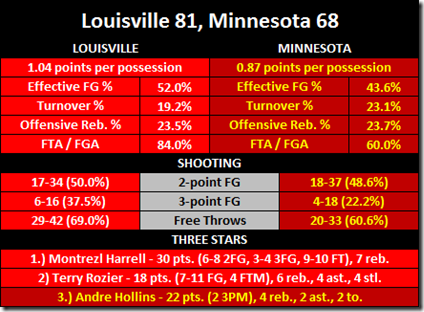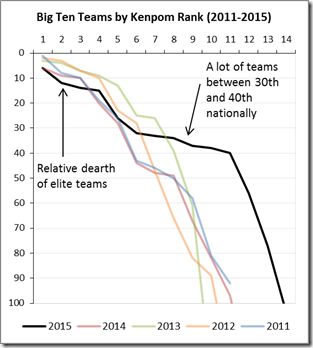Big Ten
In a universe where Bill Murray actually gets the gopher (source).
1. R. Pitino def. R. Pitino
The best game of college basketball’s opening weekend – one of those now-customary military appreciation contests in a weird venue (a hangar in Puerto Rico this time) – featured Rick Pitino’s Louisville Cardinals and his son, Richard’s Minnesota Golden Gophers. It was a predictably sloppy game, partially because of the heat that required several stoppages in play to wipe perspiration off of the court, partially because it was the season-opener for both teams.
In any case, it was an ugly game. There were a combined 60 fouls in the game, the two teams combined for more made free throws (49) than made field goals (45), and half-court offense for both teams looked like far more difficult than it should have. All of these early-season gimmick locales effectively dilute the quality of play because of the unusual environments and this game fell victim to that also. It wasn’t competitive either: Minnesota held an early 14-10 lead, but Louisville ripped off a 19-2 run. The Gophers didn’t get the deficit to two possessions for the rest of the game.
In the end, Louisville won because Rick was playing with a stacked deck: future lottery pick Montrezl Harrell was outstanding – efficient, with 30 points on 17 shot equivalents – and showcased not only his aggressive and physical interior play, but a good-looking jump shot as well. Minnesota’s backcourt of Deandre Mathieu and Andre Hollins is great in its own right, but they were simply outclassed by Chris Jones and Terry Rozier. Few teams have a guard tandem that can defend like those two and even fewer have a big man who’s comparable to Montrezl Harrell.
2. #lukewarm #gopher #takes
Not a whole lot can be drawn from a game like this – Louisville might be the best team Minnesota faces all year and the game was in a structure built to store helicopters in the Caribbean.
Still, a few observations:
- Mo Walker > Elliott Eliason. Minnesota’s senior center tandem split the minutes evenly, but Walker got the start and outplayed Eliason against the Cardinals. Louisville didn’t bother to double Walker on post-ups, and he took advantage – he also ran the floor well in transition and had a nice drive-and-dish from the perimeter.
- The four spot was a disaster. Understandable, when guarding Harrell, but the Gopher four men struggled on offense (against a zone) as well. Joey King should hold down the position but he didn’t play well and Bakary Konate, Charles Buggs, and Josh Martin didn’t impress in relief.
- Nate Mason should contribute this year. Minnesota’s freshman guard had an unenviable opponent in his first college game, but he held up decently well: 10 points (but four missed free throws), 5 rebounds, 2 assists (and 2 turnovers). Pitino should just rotate Mathieu, Hollins, and Mason at the two guard spots.
- Auto-benching Mathieu was stupid. When Deandre Mathieu picked up his second foul at 9:21 remaining in the first half, Louisville led by just three points – when he got back after halftime, the lead was thirteen. Mathieu didn’t play particularly well but he had just 3 fouls per 40 minutes last season and didn’t foul out anyways. Don’t automatically bench guys.
- Other than that: Andre Hollins looked good and Carlos Morris didn’t; The hyper-aggressive Louisville trapping zones and half-court 2-3 zone gave Minnesota a ton of problems (and it’s easy to foresee the younger Pitino molding the Gophers into a defense like that in time); Minnesota’s jerseys were awful.
[After THE JUMP: In the Navy, where something something weird guys.]
Kicking off a weekly Big Ten hoops column highlighting ten—not fourteen—of the most interesting teams, games, players, storylines, and statistics in the best basketball conference in the country.
1. The Big Ten has an enormous middle class
Wisconsin’s clear status as the frontrunner is the strongest preseason narrative surrounding the Big Ten and while the Badgers are compelling in their own right (aside from their unaesthetic style, of course), there’s another storyline that may not be getting enough attention: the middle of the Big Ten is as strong as ever and the fight for survival in the morass of teams directly behind Wisconsin will provide quality, reasonably high-stakes basketball on a near-nightly basis.
There are the Badgers, and there’s everyone else—you could take Illinois, Iowa, Michigan, Michigan State, Minnesota, Nebraska, and Ohio State and put them in almost any order, 2-through-8 looks so fluid in the Big Ten. To the point, Ken Pomeroy’s ratings have one team in the top ten (Wisconsin), but eleven in the top forty. Dan Hanner’s projections corroborate: Wisconsin—and nobody else—is in the top ten, but there are five in the top 25 and nine in the top 40.
It’s unlikely that there will be eleven of fourteen teams in the top forty by season’s end—Indiana (26) and Purdue (40) immediately stand out as overrated by Pomeroy’s system—but there should be a great number of enjoyable games between the middle-tier teams. That should be the biggest intriguing thing about the league this season: the title race likely won’t be very suspenseful, but the jockeying for position in the standings (and eventually on the seed lines for the NCAA Tournament) will be fascinating. The Big Ten will be a conference of staunchly upper-middle class teams this season—filling new subdivisions along artificial lakes and living the American Dream.
2. Top-40 Kenpom teams often make the tournament
Since the tournament expanded from 65 to a nonsensical 68, only two top-forty teams per season were excluded from the NCAA Tournament. Of those, Wichita State—ranked 59th entering the tournament—won the NIT, Stanford—ranked 53rd—won it, Baylor defeated Iowa in the NIT final, and SMU lost in the final (to Minnesota) last season.
Pomeroy’s preseason top-forty has eleven Big Ten teams (Wisconsin 6, MSU 12, OSU 14. Michigan 15, Indiana 26, Iowa 32, Maryland 33, Nebraska 34, Minnesota 37, Illinois 38, Purdue 40) and, because of the inevitable cannibalization that comes along with the zero-sum nature of conference play, it’s essentially impossible for all of those teams to finish that highly. Still, the above chart is illustrative of a basic implication in Pomeroy’s ratings: the Big Ten probably has a lot of tournament-caliber teams and monitoring which ones fall on the right and wrong sides of the NCAA bubble will surely be a compelling late-season storyline.
[After the JUMP: who's in? Who's out? Does age help you anymore?]
Another big commit for Michigan, and we're back on the front page. A couple services should be revamping their rankings in the coming weeks, so keep an eye out for that as well. Action since last rankings:
8-7-1 Illinois gains commitment from Taylor Barton.
8-8-11 Michigan gains commitment from Ondre Pipkins. Indiana gains commitment from Shawn Heffern. Michigan State gains commitment from Kodi Kieler.
8-9-11 Indiana gains commitment from Sebastian Smith. Ohio State gains commitment from Roger Lewis. Minnesota "gains" commitment from Nick Rallis.
8-10-11 Nebraska gains commitment from Deion Jones. Penn State gains commitments from Eugene Lewis and Tommy Schutt.
8-12-11 Penn State gains commitment from Armani Reeves. Wisconsin gains commitment from Walker Williams.
Chart? Chart:
| Big Ten+ Recruiting Class Rankings | ||||||
|---|---|---|---|---|---|---|
| Rank | School | # Commits | Rivals Avg | Scout Avg | ESPN Avg | 24/7 Avg |
| 1 | Michigan | 22 | 3.45 | 3.64 | 3.41 | 3.50 |
| 2 | Notre Dame | 13 | 3.31 | 3.77 | 3.46 | 3.46 |
| 3 | Penn State | 16 | 3.19 | 3.38 | 3.31 | 3.00 |
| 4 | Ohio State | 12 | 3.25 | 3.42 | 3.17 | 3.33 |
| 5 | Michigan State | 14 | 3.00 | 3.14 | 2.93 | 3.00 |
| 6 | Wisconsin | 9 | 3.11 | 3.33 | 3.11 | 2.89 |
| 7 | Indiana | 17 | 2.24 | 2.76 | 2.63 | 2.71 |
| 8 | Northwestern | 13 | 2.62 | 2.69 | 2.38 | 1.92 |
| 9 | Minnesota | 18 | 2.22 | 2.38 | 2.12* | 1.88 |
| 10 | Nebraska | 6 | 3.17 | 3.33 | 3.00 | 3.33 |
| 11 | Iowa | 9 | 3.00 | 3.00 | 3.00 | 2.89 |
| 12 | Purdue | 11 | 2.45 | 2.27 | 2.40 | 2.00 |
| 13 | Illinois | 8 | 2.13 | 2.63 | 2.50 | 2.00 |
*ESPN doesn't rate JUCOs, so Isaac Fruechte is not included in Minnesota's average, Darius Stroud doesn't count against Indiana's average, and Steffon Martin is excluded from Purdue's.
On to the full data, after the jump.





21